- Author: Lenya Quinn-Davidson
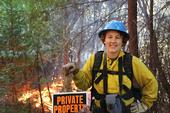
On Monday, Oct. 17, participants will gather in northwestern California for the first-ever Women-in-Fire Prescribed Fire Training Exchange (WTREX). The 12-day hands-on prescribed fire training, modeled after similar TREX events that take place across the country, will include participants with a full range of fire qualifications—from beginners to seasoned professionals—and from a diversity of backgrounds, including federal and state agencies, non-governmental organizations, tribes, universities, and more.
Participants are traveling from 12 different states and four countries, and will include 38 women and six men. This event will transcend the usual TREX emphasis...
- Author: Ann King Filmer
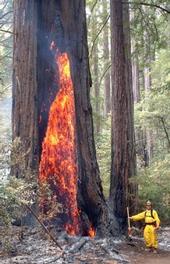
California’s renowned coast redwood trees, previously believed to be fireproof, are now more than four times more susceptible to wildfire injury in coastal forest areas infested with the sudden oak death pathogen. These redwoods are now as susceptible to wildfires as other trees.
Millions of trees, including tanoaks, coast live oak, California bay laurels, and many other forest species have been killed by sudden oak death in coastal areas of central and northern California, and Oregon. The pathogen, Phytophthora ramorum, was first linked to the massive tree death in the mid-1990s.
David Rizzo, professor in the Department of Plant...
- Author: Kim Ingram
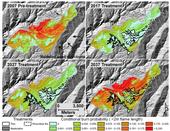
The University of California Cooperative Extension (UCCE) recently co-hosted a field trip with the U.S. Forest Service to view the implementation of a forest fuels reduction project on the Tahoe National Forest.
Over 45 stakeholders, including representatives of state, federal, and local government, industry and environmental groups and local residents attended to see the project, known as the "Last Chance Project," which involves thinning the forest by removing small and medium-sized trees, masticating or mowing down brush, and burning dead material through prescribed fire. The work, being done by Sierra Pacific Industries, under contract to the U.S. Forest Service, should be completed by fall 2012.
University...
- Author: Pamela Kan-Rice
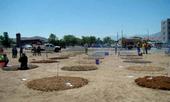
The Las Conchas fire that recently consumed nearly 137,000 acres in Los Alamos, N.M., serves as a reminder of how quickly fire can move if given fuel. I can’t light a barbecue with matches and lighter fluid, but a small ember drifting on the wind can find so many ways to burn down people’s homes if given the right conditions.
Removal of vegetation near Los Alamos National Laboratory, which is part of the UC system, created a buffer and helped spare the lab from the Las Conchas fire, which came within 50 feet. Creating a buffer is one of many preventive measures that can be taken to protect property from wildfires.
In a wildfire-prone area, even if you have a house with a concrete tile roof and noncombustible siding, an...
- Author: Chris M. Webb
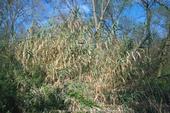
In the early 1800s, European immigrants introduced the fast-growing giant reed arundo (Arundo donax) into California to use the canes for musical instruments. The plants were also used for erosion control and the reeds used for thatched roofing. However, it has since naturalized and become a serious pest in the state's natural waterways.
Arundo can grow at a rate of four inches per day and can reach heights of 30 feet. It reproduces and spreads when sections of the stem or root break off and float downstream.
Dense stands of arundo displace native riparian species. The plant requires a significant amount of water, reducing fish, wildlife and people. In addition, clumps of arundo and the soil around their roots...



